The digital landscape has changed drastically, especially with the increasing focus on user privacy and the gradual phasing out of third-party cookies.
First-party data has become a strong arm in this direction, helping advertisers stay competitive.
Whether you run Google Ads or any digital marketing campaign, first-party data isn’t an option but a necessity that will be required.
While that shift can certainly be challenging, it also presents a tremendous opportunity to better know your audience and build more customized and effective ad campaigns.
In this article, we’ll explore the role of first-party data, particularly in Google Ads, and how it can be leveraged in a cookieless future.
With increased regulations and the decline of third-party data, your ability to collect and properly utilize first-party data will directly impact the success of your advertising efforts.
Let’s delve into what first-party data is, why it’s becoming so valuable, and how you can make the most of it for your Google Ads strategy.
- First-Party Data: The New Frontier in Digital Advertising
- What a Cookieless World Means for Google Ads
- First-Party Data Strategy for Google Ads
- Tools and Technologies to Optimize First-Party Data Use
- First-Party Data and Privacy Regulations: The Future Trend Arises
- First-Party Data at the Core: The Future of Google Ads in a Cookieless World
- First-Party Data in Google Ads: Commonly Asked Questions
First-Party Data: The New Frontier in Digital Advertising
First-party data is information that you collect directly from your audience.
It includes customer data from your website, app, or other digital interactions where users voluntarily provide their information.
Unlike third-party data, which comes from external sources, first-party data belongs to your business and offers a more accurate and nuanced understanding of your customers.
But why is first-party data suddenly so critical?
It all comes down to data privacy.
With regulations such as the General Data Protection Regulation (GDPR), along with browsers allowing users to block third-party cookies, advertisers are losing easy access to third-party data.
This makes first-party data increasingly valuable and one of the few reliable resources available to continue targeting ads effectively.
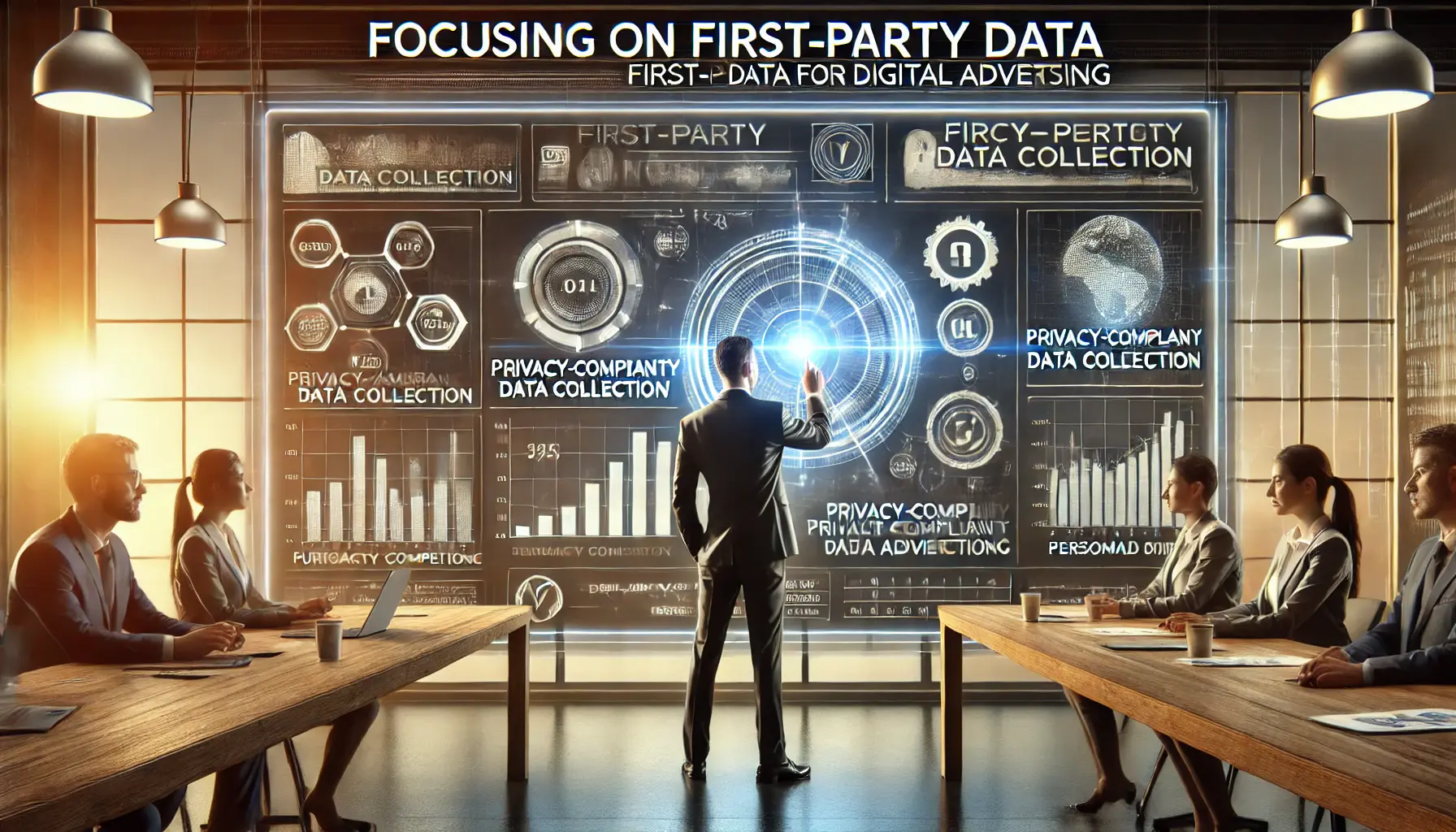
Visualizing the benefits of first-party data in personalized and privacy-compliant digital marketing.
Benefits of Focusing on First-Party Data
- Accuracy: First-party data is more accurate because it comes directly from your customers.
- Compliance: The use of first-party data inherently keeps you compliant with privacy laws and regulations, since it’s data you collect and manage yourself.
- Personalization: Having detailed information about your customers allows you to run more targeted, personalized ads, resulting in better campaign performance.
Now, let’s zoom in on exactly why first-party data holds such high value today.
First-party data offers direct insights from your audience, making it invaluable for personalized marketing efforts. As privacy laws tighten, it ensures compliance while delivering more accurate targeting.

The transformation of Google Ads strategies in a cookieless future, focusing on privacy and innovative advertising.
What a Cookieless World Means for Google Ads
The advertising industry is in the middle of a huge transition, particularly with the abolition of third-party cookies, which were once used to track users across the web.
For years, marketers leveraged third-party cookies to understand the browsing habits of users and target ads accordingly.
However, as privacy regulations tighten and consumers become more aware of how their data is utilized, browsers such as Google Chrome are joining the movement to block third-party cookies.
This shift toward a cookieless world dramatically changes how businesses use platforms such as Google Ads for their advertising needs.
Without relying on third-party cookies for retargeting and gathering audience insights, advertisers must adapt their strategies.
Fortunately, Google is also supporting this shift by offering new tools and technologies designed to preserve user privacy while still enabling advertisers to target their audiences effectively.

The transition from third-party cookies to privacy-centric tools in the future of digital advertising.
Google to End Third-Party Cookies
Due to growing privacy concerns, Google has announced that it will phase out third-party cookies by 2024.
This decision aligns with actions taken by other browsers like Firefox and Safari, both of which have already blocked third-party cookies.
Instead, Google is developing its Privacy SandboxGoogle's initiative to create a set of web standards to protect user privacy while still allowing for targeted advertising. initiative, which introduces new technologies to protect users’ privacy while continuing to support digital advertising.
Some of the features introduced in Privacy Sandbox include Federated Learning of Cohorts (FLoC), which groups users into anonymized cohorts based on similar browsing behaviors, and TopicsA Privacy Sandbox proposal that replaces FLoC, aiming to target ads based on users' interests without identifying them personally., which identifies user interests without tracking individual users.
These features aim to enable interest-based advertising without compromising user privacy.
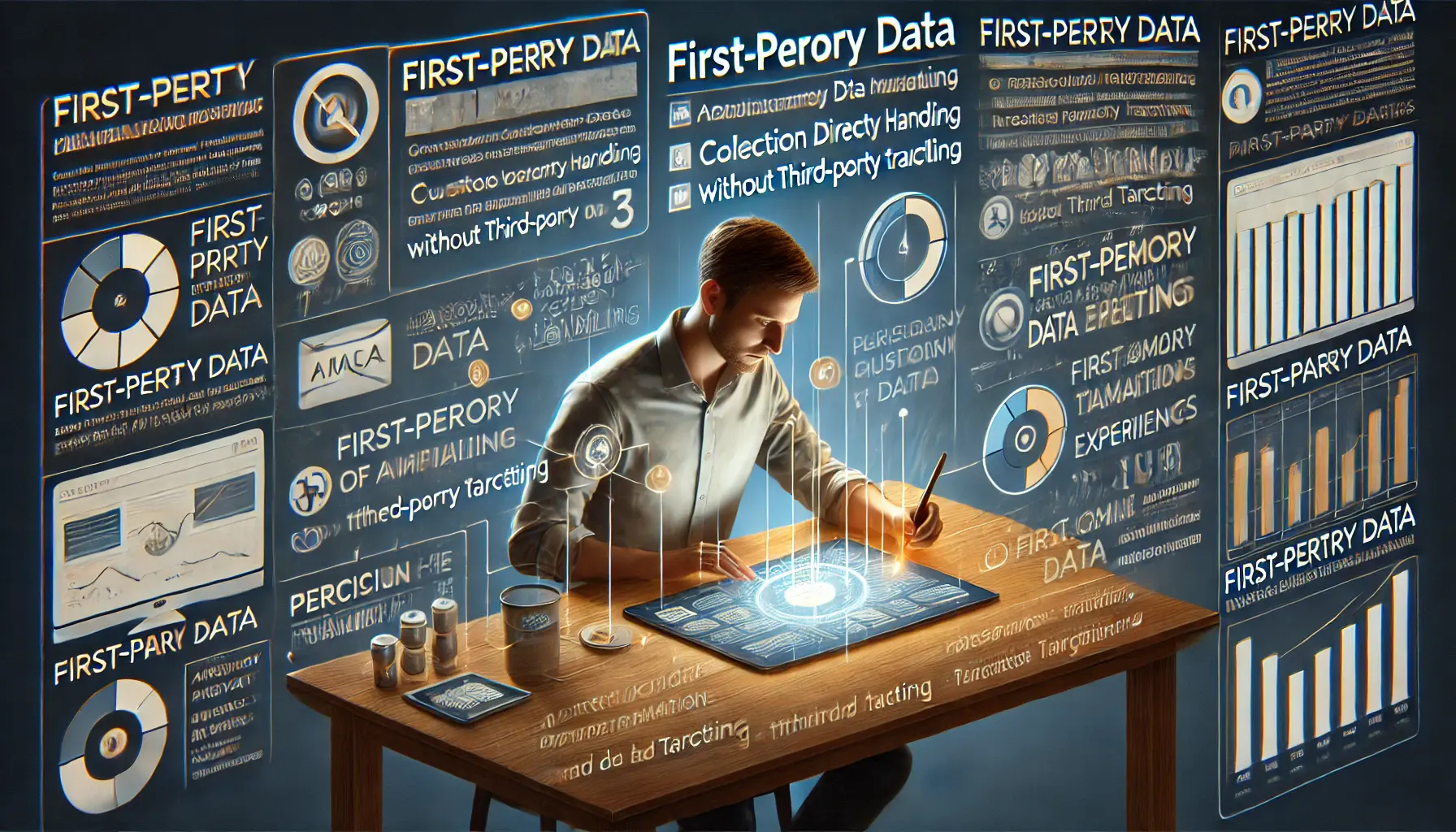
Integrating first-party data into personalized, privacy-compliant ad campaigns.
How First-Party Data Fits In
As third-party cookies are phased out, first-party data will play a critical role for businesses using Google Ads.
First-party data is collected directly from your users through interactions on your website or app, allowing you to create accurate audience profiles without violating privacy laws.
This data is more reliable, helping you build more personalized and effective ad campaigns.
Google encourages advertisers to start focusing on first-party data now.
Integrating first-party data into your Google Ads strategy allows for better audience segmentation, improved targeting, and more effective ads, even without third-party cookies.
By doing so, you can future-proof your campaigns and ensure they perform well in the cookieless era.
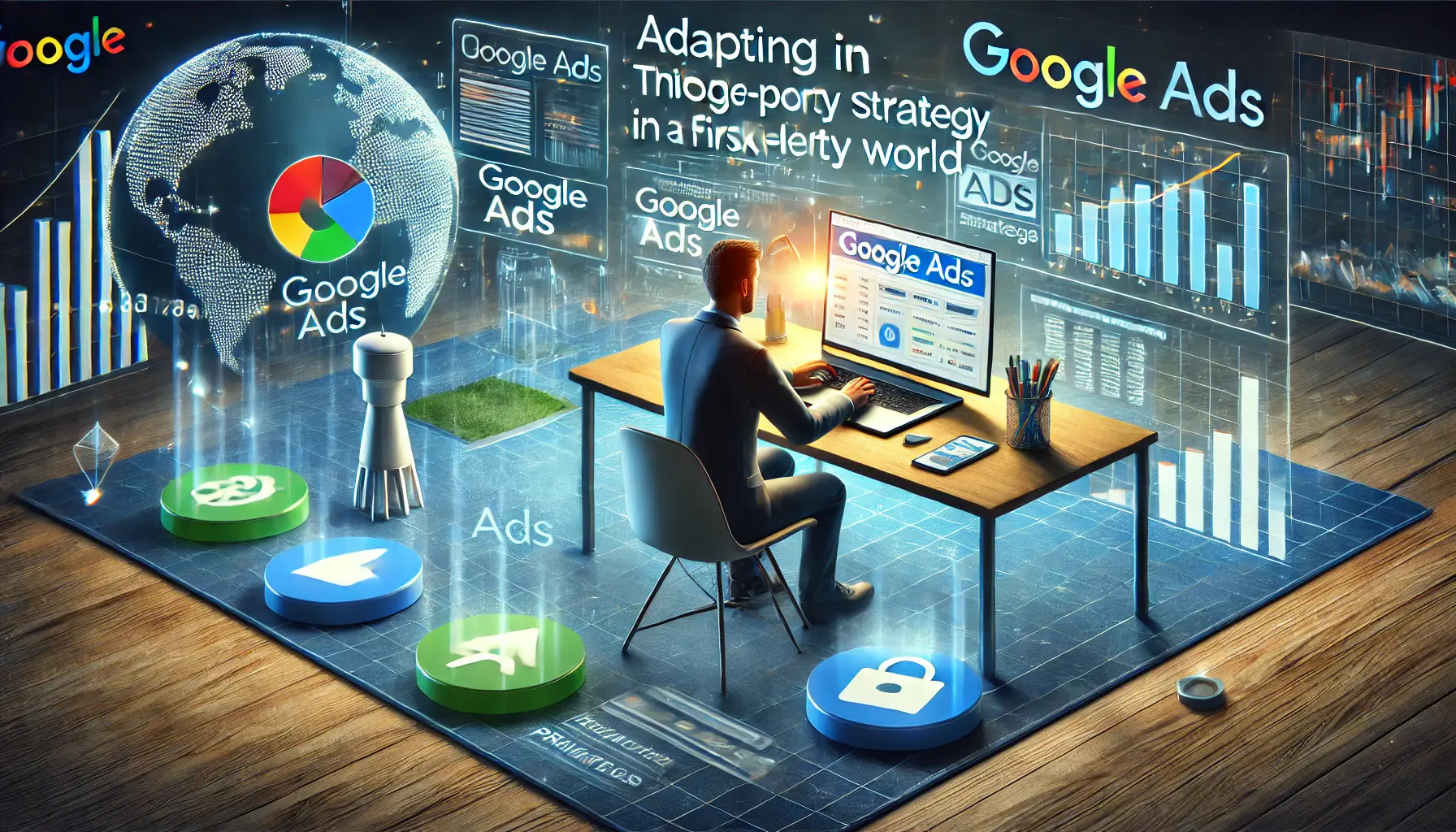
Adapting Google Ads strategies to a cookieless world with a focus on first-party data and privacy-compliant tools.
Adapting Your Google Ads Strategy for a Cookieless World
As the pressure increases, it’s time to revisit your Google Ads strategy.
Here’s how you can adapt to these changes:
- Leverage First-Party Data: Use data from your existing customers to create targeted ad campaigns.
- Embrace Google’s Privacy Sandbox: Learn how to use the new targeting tools provided by Google.
- Invest in Customer Relationships: Show users the value of sharing their data in exchange for personalized offers or exclusive content.
By embracing these changes and focusing on first-party data, your advertising efforts can continue to meet your goals in the evolving digital landscape.
The shift away from third-party cookies challenges advertisers but also opens doors for more privacy-centric advertising strategies. First-party data will lead the way in this new era.
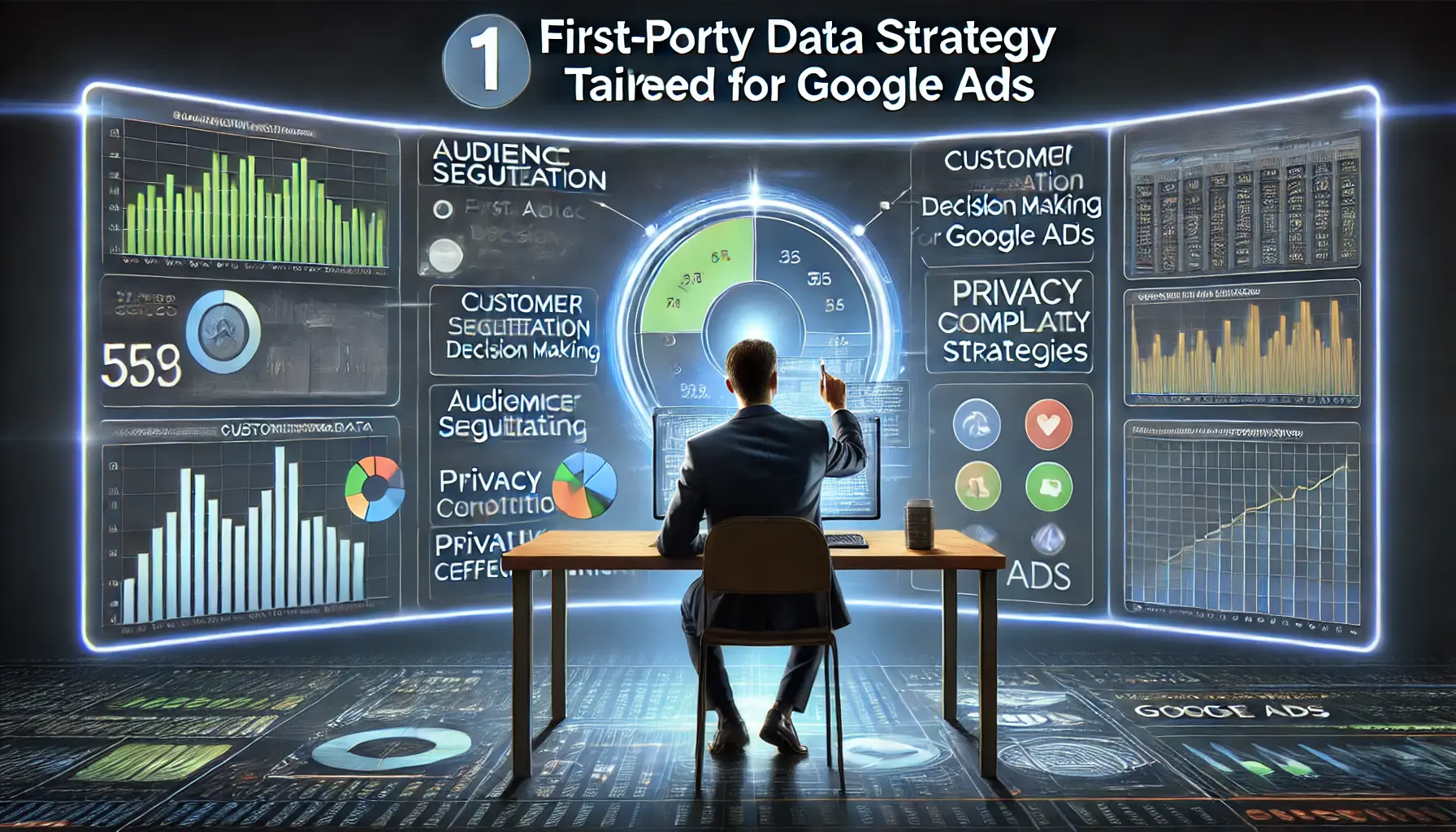
Optimizing Google Ads with a first-party data strategy for better audience targeting and personalized campaigns.
First-Party Data Strategy for Google Ads
Building a strong first-party data strategy is crucial to ensuring the success of your Google Ads campaigns in the cookieless world.
First-party data, which is collected directly from your customers, allows you to target the right audience without relying on third-party cookies.
However, to fully benefit from first-party data, it’s important to approach its collection, management, and integration with thoughtfulness and ethics.
The key to a successful first-party data strategy is understanding your customers and using the data you collect to create personalized experiences that resonate with them.
Now, let’s explore the key steps involved in building a first-party data strategy that works for your Google Ads campaigns.

Collecting first-party data ethically and legally with proper consent and transparency.
How to Collect First-Party Data Legally and Ethically
With the rise of privacy regulations like GDPR and CCPACalifornia Consumer Privacy Act, a law designed to enhance privacy rights and consumer protection for residents of California, USA., collecting first-party data must be done legally and ethically.
Be transparent with users about the type of data you collect and how you plan to use it.
Always obtain explicit consent before collecting personal data.
Offering value in exchange for data, such as personalized content or discounts, encourages customers to willingly share their information.
- Clear Privacy Policies: Your privacy policy should be easy to access and explain how user data is collected, stored, and used.
- Consent Management: Leverage consent management tools to help you stay compliant with privacy regulations and give users control over their data.
- Data Minimization: Only collect the data you need. Unnecessary data collection can lead to privacy concerns and decrease user trust.

Optimizing ad campaigns using CRM data to personalize and target customers effectively.
Utilizing CRM Data for Personalized Ad Campaigns
One of the most powerful ways to leverage first-party data is through your customer relationship management (CRM) system.
By integrating CRM data into your Google Ads campaigns, you can create highly personalized ad experiences.
CRM data, such as customer purchase history, preferences, and behavior, helps you create targeted campaigns that appeal directly to your audience’s interests and needs.
For instance, if a customer has recently purchased a product, you can target them with ads for complementary products.
This level of personalization not only enhances your campaign performance but also strengthens customer loyalty.

Integrating first-party data into Google Ads for precise audience segmentation and personalized campaigns.
Integrating First-Party Data with Google Ads
To get the most out of your first-party data, it should be seamlessly integrated into your Google Ads account.
Google offers several tools to facilitate this, allowing you to use data such as email addresses to create custom audience segments.
By integrating your data, you can segment your audience and display ads that are most relevant to their behaviors and preferences.
- Customer Match: Upload customer data, such as email addresses or phone numbers, into Google Ads to show users highly relevant ads.
- Lookalike Audiences: Use data from your most engaged customers to build an audience that resembles them, potentially interested in your product or service.
- Dynamic Remarketing: Show products or services dynamically in your ads that are relevant to users based on their previous interactions with your website or app.
By strategically integrating first-party data into your Google Ads strategy, you can deliver more targeted and personalized ads that drive better results.
Building a first-party data strategy ensures compliance with privacy laws while optimizing ad targeting and personalization.

Optimizing first-party data usage with advanced tools like CDPs, Google Analytics, and machine learning technologies.
Tools and Technologies to Optimize First-Party Data Use
Tools and technologies that help with first-party data collection, management, and optimization are essential in the cookieless future for maintaining successful advertising campaigns, particularly on Google Ads.
First-party data is becoming the most valuable type of data with third-party cookies being phased out, but it is only as valuable as your ability to use it effectively.
The key is to implement technologies that protect user privacy while also enabling you to extract meaningful insights from your data to fuel your Google Ads strategy.
Several tools are available to make this process easier for businesses, helping to optimize first-party data collection and usage in line with privacy regulations.
With data management platforms (DMPs) and machine learning algorithms, data collection, audience segmentation, and ad targeting can be automated.
Below are some of the top tools and technologies to help you optimize your first-party data use.

Top tools like CDPs and consent management systems streamline first-party data collection and ensure privacy compliance.
Top Tools for Collecting and Managing First-Party Data
These tools ensure data is collected in compliance with privacy regulations and allow for effective analysis and usage for targeted advertising:
- Customer Data Platforms (CDPs): Tools like Segment and Tealium allow businesses to collect, organize, and unify first-party data from various touchpoints, providing a single customer view.
- Google Analytics 4: Google Analytics 4 is built to work with first-party data, providing insights into user behavior without needing third-party cookies. It helps businesses better understand their audience, making targeting and personalization in Google Ads more effective.
- Consent Management Platforms (CMPs): Platforms like OneTrust or Cookiebot help businesses stay compliant by managing user consent and ensuring that data collection practices are transparent and legal.

Google’s Privacy Sandbox integrates first-party data with privacy-preserving technologies for secure ad targeting.
Google’s Privacy Sandbox: What It Means for First-Party Data
Google’s Privacy Sandbox aims to replace third-party cookies with privacy-preserving alternatives, allowing advertisers to continue targeting ads and measuring performance while protecting user privacy.
One key aspect of Privacy Sandbox is its reliance on first-party data.
For example, Federated Learning of Cohorts (FLoC), originally part of Privacy Sandbox, has evolved into ‘Topics.’ This technology groups users into interest categories without identifying them personally, making it easier for businesses to target ads without relying on third-party cookies.
Through Privacy Sandbox, businesses will still be able to collect and use their first-party data to create personalized ad experiences but will need to rely more heavily on their own data rather than third-party sources.

Machine learning optimizes first-party data for precise audience segmentation and predictive marketing strategies.
How Machine Learning Can Optimize First-Party Data
Machine learning (ML) algorithms can analyze vast amounts of first-party data to identify patterns, predict user behavior, and segment audiences for more precise targeting in Google Ads campaigns.
ML can help identify the most valuable customer segments, predict which users are likely to convert, and automatically adjust bids in real-time to maximize performance.
Here are some ways you can use machine learning to optimize first-party data:
- Google Ads Smart Bidding: This machine learning-powered tool optimizes your bids for conversions or conversion value based on the data you provide, ensuring your campaigns perform as well as possible.
- Dynamic Search Ads (DSA): DSAs use machine learning to create ads based on your website’s content, resulting in highly relevant and personalized ads that match user intent.
- Lookalike Audiences: By using machine learning, Google can create lookalike audiences based on your first-party data, helping you reach new users who are similar to your most valuable customers.
Incorporating machine learning into your first-party data strategy will help you optimize ad performance, enhance audience targeting, and achieve better results from your Google Ads campaigns.
Leveraging tools like Customer Data Platforms (CDPs) and Google Analytics 4 helps businesses manage and optimize first-party data effectively.

First-party data compliance with evolving privacy regulations like GDPR and CCPA is critical for future digital marketing strategies.
First-Party Data and Privacy Regulations: The Future Trend Arises
First-party data is becoming increasingly crucial for the future of digital advertising due to tightening privacy regulations and dwindling sources for third-party data.
As concerns about data privacy grow, businesses will have to strategize and adapt their methods for collecting and storing customer information.
First-party data has gained significant appeal for advertisers in response to regulations such as GDPR in Europe and CCPA in the United States.
With more regulations expected, advertisers’ reliance on first-party data will only increase.
In this evolving landscape, first-party data is set to become a cornerstone of digital marketing strategies.
Companies that focus on building trust with consumers by being transparent about their data practices will not only comply with regulations but also gain a competitive edge.
As we look to the future, it’s crucial to understand how privacy regulations will shape the digital advertising ecosystem and how businesses can prepare to thrive.

The shift to first-party data in advertising improves personalized ad targeting and enhances compliance with privacy regulations.
The Growing Importance of First-Party Data in Advertising
First-party data is becoming increasingly important as third-party data becomes less available due to privacy concerns and regulatory changes.
Advertisers who rely on first-party data are better positioned to deliver personalized ad experiences that are relevant to users while staying compliant with evolving privacy laws.
As more users become aware of their privacy rights and opt out of third-party tracking, businesses with strong first-party data strategies will continue to create effective ad campaigns.
Collecting data directly from customers through website interactions, surveys, and subscriptions helps companies build accurate audience profiles that can be used to personalize content and enhance user experiences.

Privacy regulations such as GDPR and CCPA are reshaping how data-driven ads are created and targeted.
How Privacy Regulations Will Impact Data-Driven Ads
New regulations like GDPR and CCPA have already impacted how businesses handle data.
These regulations focus on user consent, transparency, and the right to access or delete personal information.
As a result, businesses must obtain clear consent from users before collecting or using their personal data for advertising purposes.
Additionally, companies need to stay updated on changes to privacy laws and adjust their data practices accordingly.
Non-compliance with privacy laws can result in significant fines and harm to a brand’s reputation.
On the other hand, compliance fosters consumer trust, leading to stronger relationships with your audience and a more loyal customer base.

Proactively preparing for future changes in data privacy laws by reviewing privacy policies and using consent management tools.
Preparing for Future Changes in Data Privacy Laws
As new data privacy laws emerge, businesses must proactively adapt their data strategies to remain compliant.
This includes using consent management tools (CMPs), regularly updating privacy policies to reflect user consent, and ensuring data storage and processing align with regulatory standards.
To future-proof your business against regulatory changes, it’s important to adopt a privacy-first approach to your advertising strategy.
This means building strong first-party data practices that prioritize transparency and ensure users feel secure when sharing their data with your company.
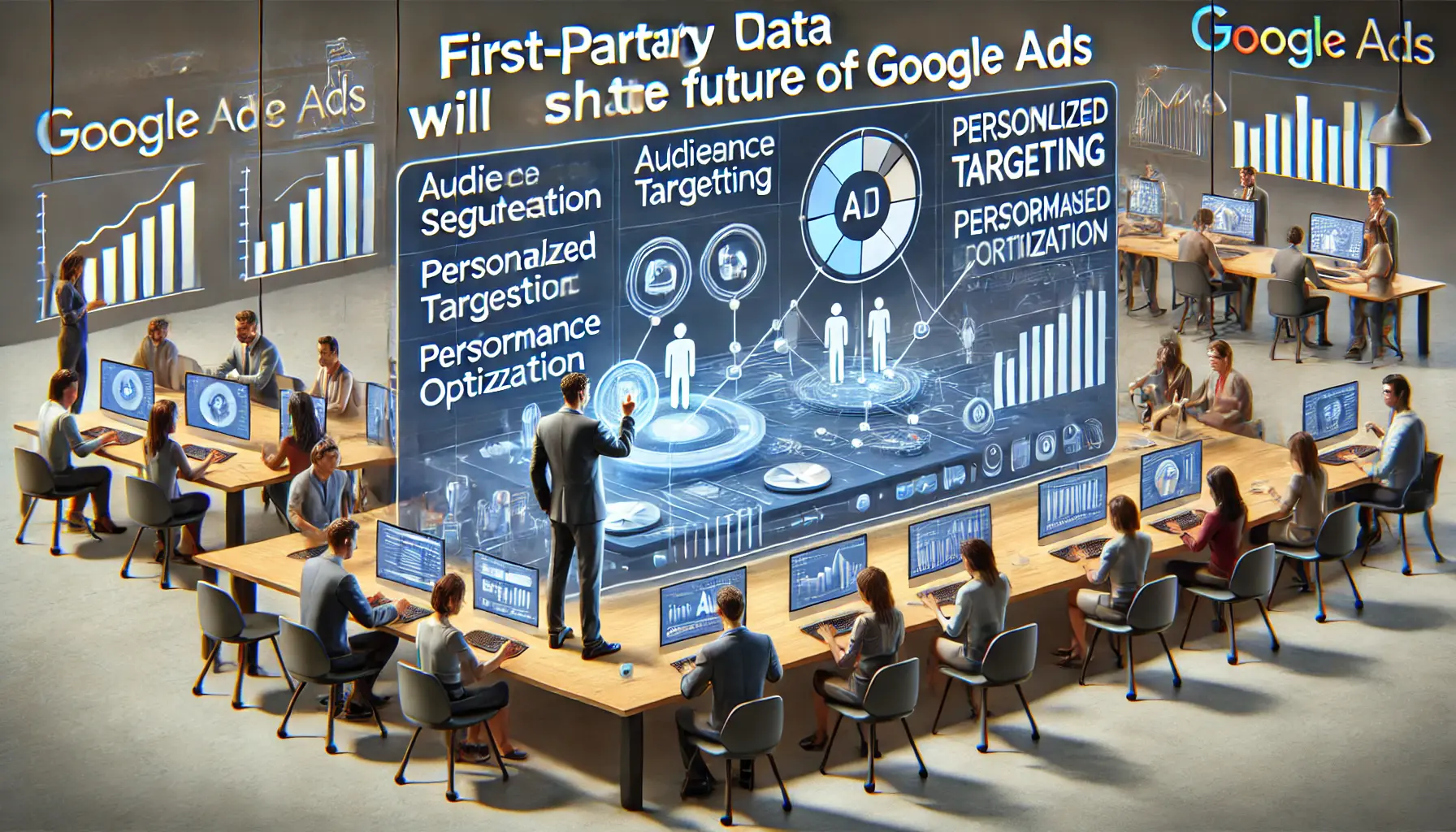
First-party data will drive the future of Google Ads, enabling more personalized ad targeting and campaign optimization.
How First-Party Data Will Shape the Future of Google Ads
As privacy restrictions continue to limit the use of third-party data, Google Ads and other advertising platforms will increasingly rely on first-party data for targeting and campaign optimization.
Advertisers who focus on effectively collecting and using first-party data will be better positioned to create personalized ad experiences and improve their return on investment (ROI).
Google has already introduced tools like Customer Match and enhanced machine learning capabilities to help advertisers make the most of their first-party data.
These tools allow businesses to develop detailed customer profiles, segment audiences, and deliver ads that are relevant to individual users—all without relying on third-party cookies.
The future of Google Ads will likely involve greater reliance on first-party data, along with the continued development of privacy-preserving technologies like the Privacy Sandbox.
Advertisers who embrace these changes and emphasize first-party data collection will be well-equipped to navigate the evolving digital landscape and achieve better ad performance.
As privacy regulations tighten, first-party data is becoming the backbone of legal and ethical advertising strategies.
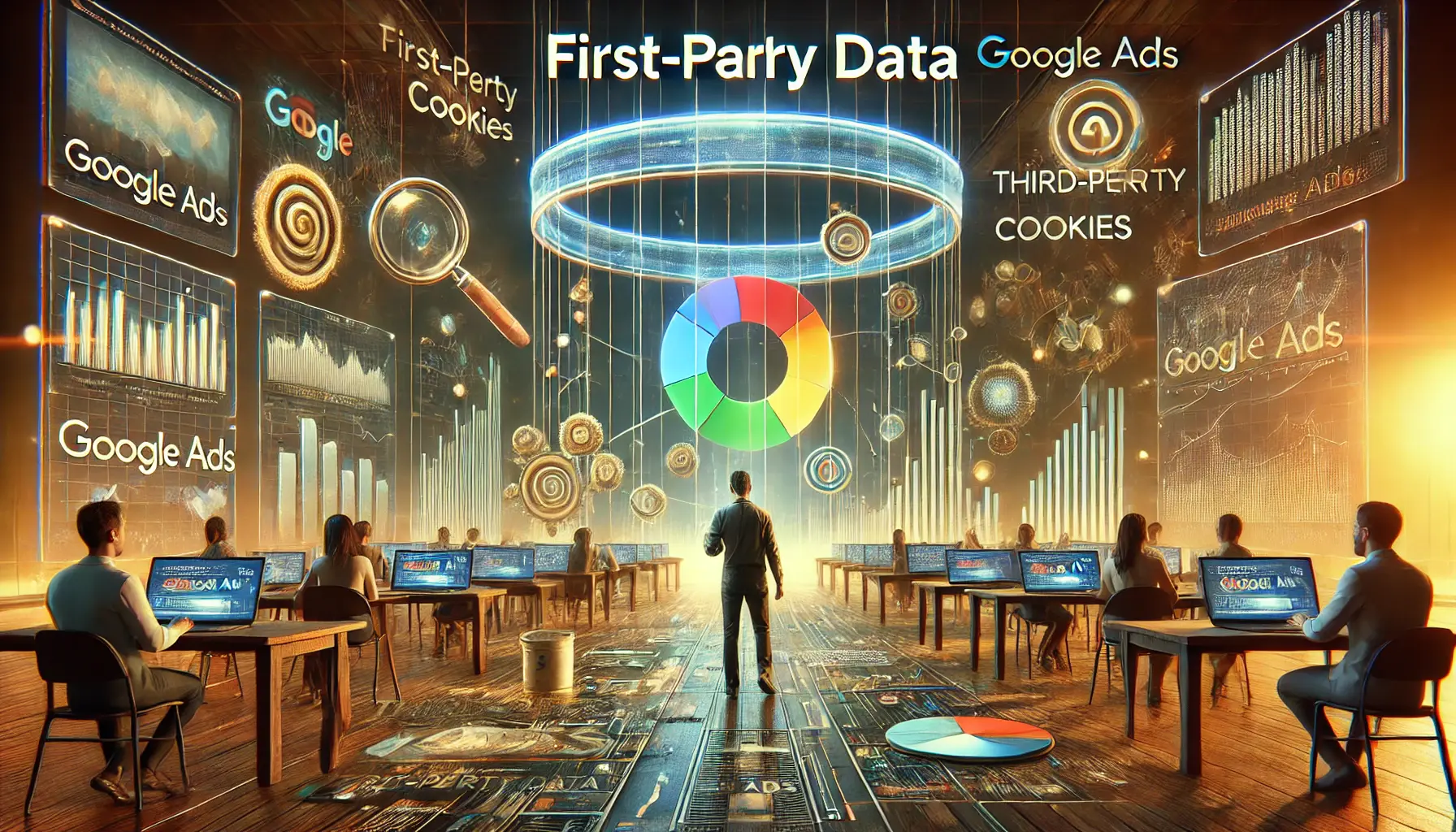
In a cookieless world, first-party data becomes the core of Google Ads strategies, driving personalized ad targeting and campaign success.
First-Party Data at the Core: The Future of Google Ads in a Cookieless World
The world of digital advertising is undergoing a major transformation, driven by the phasing out of third-party cookies and the tightening of privacy regulations.
As we move into a cookieless world, first-party data has become the key to maintaining effective and personalized ad campaigns.
Like many other platforms, Google Ads is shifting its focus toward first-party data, allowing businesses to stay connected with their audiences while protecting privacy.
First-party data enables advertisers to create richer, more personalized ad experiences by using insights directly from their customers.
This approach not only ensures compliance with regulations like GDPR and CCPA but also builds stronger customer relationships through transparent data practices.
As third-party data becomes less available, the ability to collect, manage, and optimize first-party data will become critical for businesses looking to stay competitive in this evolving landscape.

Key takeaways from first-party data strategies, highlighting data-driven decision making and performance optimization for future campaigns.
Key Takeaways
- First-party data is irreplaceable: In a world where third-party cookies are disappearing, first-party data will become the most valuable resource for delivering personalized ads while ensuring privacy compliance.
- Tools for data management: Several tools are available to help collect and manage first-party data efficiently and legally, such as Customer Data Platforms (CDPs), Google Analytics 4, and Consent Management Platforms (CMPs).
- Optimizing data with machine learning: First-party data can be optimized using machine learning algorithms like Google Ads Smart Bidding and Dynamic Search Ads to improve ad performance and enhance user targeting.
- Regulatory compliance: Regulations like GDPR and CCPA emphasize user consent, transparency, and the right to control personal data. Advertisers must align with these regulations to build trust and ensure long-term success.

Embracing first-party data is essential for future success, driving growth and innovation in personalized advertising strategies.
Embracing First-Party Data for Future Success
Advertisers who invest in developing strong first-party data strategies today will be better prepared for future challenges, whether they involve stricter privacy regulations or the continued decline of third-party data sources.
First-party data is increasingly valuable, especially within Google Ads, where tools like Customer Match allow businesses to better utilize their data to create more relevant, targeted ad campaigns.
By embracing first-party data, businesses can future-proof their advertising strategies, improve user experiences, and achieve better outcomes.
The shift toward first-party data is not just a trend—it is a critical adjustment for businesses that want to succeed in a world without cookies.
Privacy, transparency, and the effective use of first-party data will be the defining factors for success in the digital advertising ecosystem, and those who prioritize these elements will emerge as leaders in the industry.
As third-party cookies disappear, first-party data will drive the success of digital advertising campaigns, making it essential to master its collection and usage.
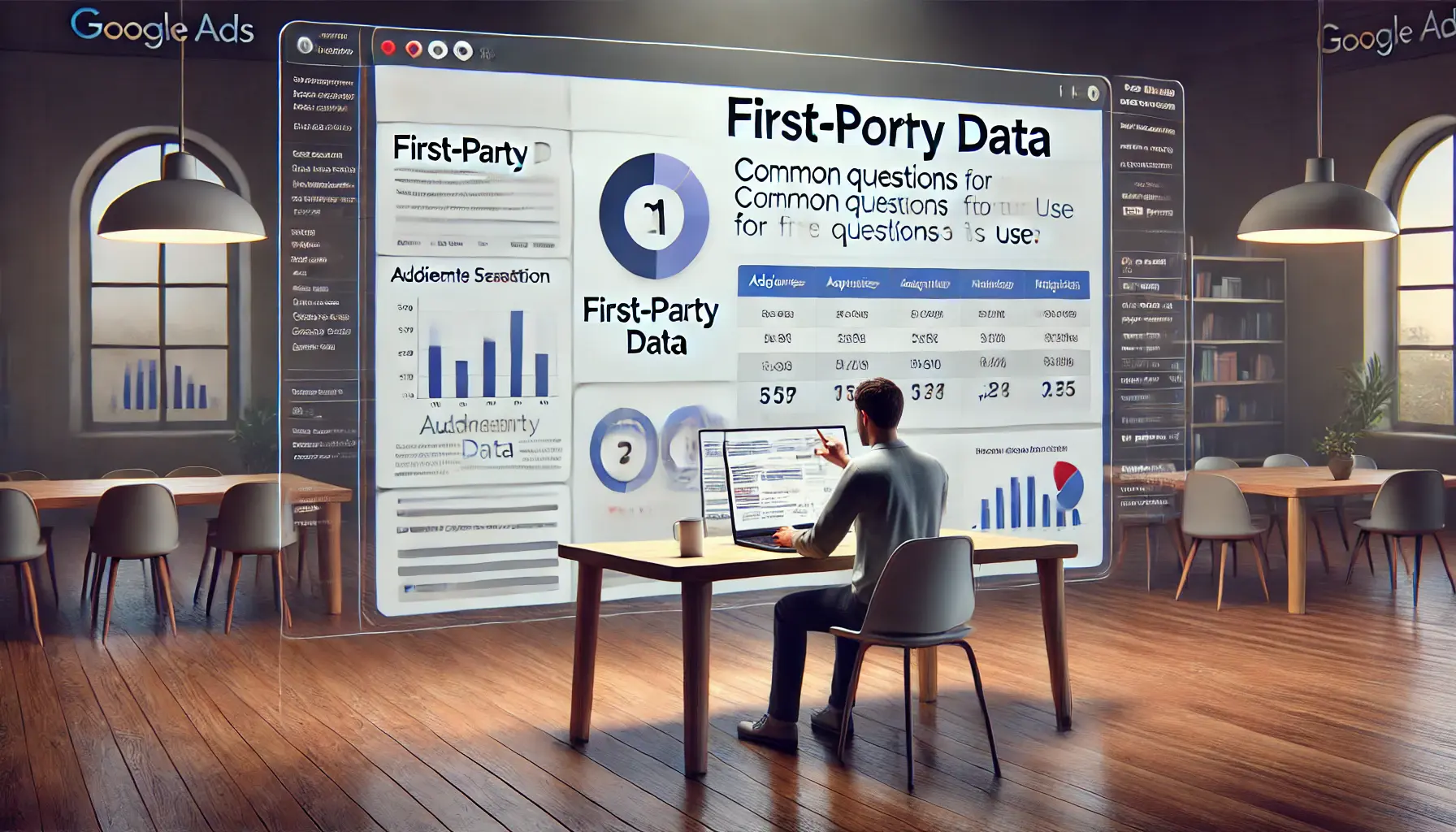
Commonly asked questions about using first-party data in Google Ads for audience segmentation and ad optimization.
Your campaigns can be managed by an agency specialized in Google Ads, check out our service page.
First-Party Data in Google Ads: Commonly Asked Questions
There are several frequently asked questions posed to businesses regarding first-party data, its significance, and its role in a cookieless world, particularly for running Google Ads campaigns.
First-party data is information you collect from users through your own platforms.
It plays a key role in personalizing ad campaigns and helps ensure your business complies with privacy regulations in a cookieless world.
First-party data originates directly from your audience, while third-party data comes from external sources.
First-party data is more accurate and reliable, making it more valuable for targeted advertising in a privacy-focused environment.
To collect first-party data legally, ensure transparency, obtain explicit user consent, and use consent management tools.
Comply with regulations like GDPR and CCPA to build trust and avoid legal penalties.
First-party data is becoming more important due to the phase-out of third-party cookies and stricter privacy regulations.
It allows businesses to continue creating personalized ads while adhering to these evolving rules.
First-party data improves audience segmentation, personalization of targeting, and ad relevancy.
Google Ads tools like Customer Match enable businesses to fully leverage first-party data for better ad performance and ROI.
Tools such as Google Analytics 4, Customer Data Platforms (CDPs), and Consent Management Platforms (CMPs) help with first-party data collection, organization, and management while ensuring compliance with privacy regulations.
Privacy regulations like GDPR and CCPA require businesses to obtain explicit user consent for data collection, ensure transparency about data usage, and give users the right to access or delete their personal data.
Compliance is essential.
Google’s Privacy Sandbox is a collection of tools and APIs designed to replace third-party cookies with privacy-preserving alternatives.
It relies on first-party data to enable targeted advertising while maintaining user privacy.









